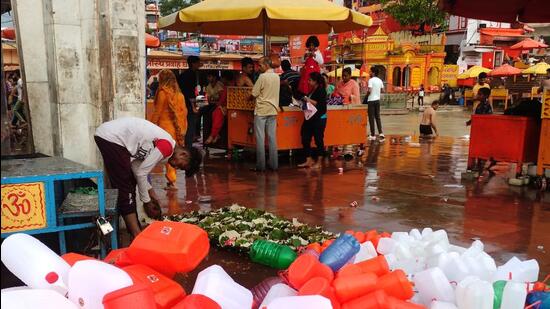Kanwar yatra: Waste management, garbage disposal top priority for authorities
According to the mela administration, about 4.5 crore Lord Shiva devotees also known as kanwariyas, are expected to arrive in Uttarakhand during July 14-26 period
The authorities in Haridwar are bracing themselves in management and disposal of waste that is expected to generate once the Kanwar yatra begins in mid-July.

This year’s yatra starts on July 14 when over 4 crore pilgrims will come to the holy city to fetch Ganga waters for two weeks.
With the Char Dham Yatra on, Haridwar is already receiving a lot of pilgrims, apart from the usual rush during festivals.
According to the mela administration, about 4.5 crore Lord Shiva devotees also known as kanwariyas, are expected to arrive in Uttarakhand during July 14-26 period.
Also Read: Kanwar yatra: Uttarakhand police releases traffic diversion plan
This record number of devotees will also result in a manifold surge in garbage and waste generation.
On normal days, about 200 metric tonnes of garbage is generated in the city.
In order to ensure cleanliness is maintained in the Ganga ghats, additional number sanitisation workers will be hired.
Not only garbage, additional sewage will also be generated in the city.
According to Jal Sansthan officials, around 85-90 million litres per day (MLD) of sewage gets generated on normal days in the city.
During the yatra, this figure is expected to see a multi-fold rise.
“From sanitation, and cleanliness, to garbage disposal, preparations have been initiated and tender process is on,” said chief town commissioner Dayanand Saraswati.
Currently, at Sarai Sewage treatment plant, 14 MLD and at Jagjeetpur, 68 MLD capacity sewage treatment plants are working, he said.
“To ensure no human waste is generated in open, at mela zone, more than 200 toilets are being set up. More than 1,500 sanitation employees are being deployed on duty for the Kanwar fair”, he said.
“All aspects and arrangements are being looked into by concerned departments and nodal agencies. From sanitation, cleanliness, security, health, maintenance of Kanwar stretch, availability of potable water to power supply, all related works will be completed by July 10,” said district magistrate Vinay Shankar Pandey.
Vyapar Mandal representatives have urged mela administration to ensure Kanwariyas don’t defecate in open by setting up of toilets at various places throughout the Kanwar stretch.
“Open defecation leads to pollution in the river bed so this aspect needs to be looked at on a priority basis. Setting up of temporary toilets is necessary,” said city trader union representative Tej Prakash Sahu.
Ganga Sabha which manages the affairs of Har-ki-Pauri will be urging Kanwariyas to not pollute the scared Ganga through any means.
“Through public announcement systems, we will generate awareness among Kanwariyas to ensure they don’t leave any waste, litter or pollute the sacred Ganga during the pious Kanwar pilgrimage,” said Ganga Sabha president Pradeep Jha.
Plastic waste generated due to plastic, polythene bags, and cans is expected to reduce from July 1 as their usage and sale has been prohibited in the state.
At Har-ki-Pauri and adjacent Ganga ghats, instead of plastic cans, now metallic cans, bamboo and glass bottles are being sold.
Also, the plastic sheets on which pilgrims, tourists, Kanwariyas and vendors used to sit, have also been banned and use of jute mats is being promoted, instead.
“Every Kanwariya fetches holy Ganga Jal. As plastic cans are prohibited, it will lessen plastic waste generation. Stalls have been set up from where devotees can buy the eco-friendly non-plastic cans,” said additional town commissioner ML Shah.
He added that waste bins are also being put up on Kanwar yatra stretch and parking lots to collect and dispose of the waste that will be generated.
The 2,525 km long Ganga, which originates in Uttarakhand, is home to over 140 fish species, 90 amphibian species and the endangered Ganges River dolphin, according to experts.
Environmentalists have consistently raised their concerns on the pollution of the sacred river, caused by various activities of nearly 40 crore people living close to its banks.
In a first in India, in March 2017, Uttarakhand high court had accorded the status of ‘living entity’ to Ganga and Yamuna rivers bestowing on them the same legal rights as a person. However, later the Supreme Court stayed the HC order after the state government filed a special leave petition against it.





